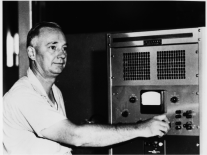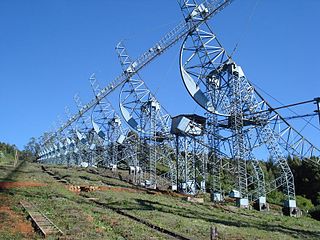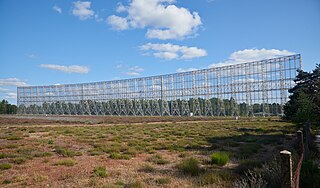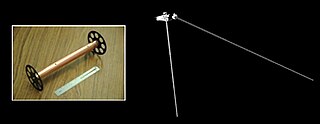
A radio telescope is a specialized antenna and radio receiver used to detect radio waves from astronomical radio sources in the sky. Radio telescopes are the main observing instrument used in radio astronomy, which studies the radio frequency portion of the electromagnetic spectrum emitted by astronomical objects, just as optical telescopes are the main observing instrument used in traditional optical astronomy which studies the light wave portion of the spectrum coming from astronomical objects. Unlike optical telescopes, radio telescopes can be used in the daytime as well as at night. Because an antenna sees only one spot at a time, the image is produced by scanning the sky line by line, using earth rotation and antenna motion.

Radio astronomy is a subfield of astronomy that studies celestial objects at radio frequencies. The first detection of radio waves from an astronomical object was in 1933, when Karl Jansky at Bell Telephone Laboratories reported radiation coming from the Milky Way. Subsequent observations have identified a number of different sources of radio emission. These include stars and galaxies, as well as entirely new classes of objects, such as radio galaxies, quasars, pulsars, and masers. The discovery of the cosmic microwave background radiation, regarded as evidence for the Big Bang theory, was made through radio astronomy.

Grote Reber was an American pioneer of radio astronomy, which combined his interests in amateur radio and amateur astronomy. He was instrumental in investigating and extending Karl Jansky's pioneering work, and conducted the first sky survey in the radio frequencies.

The Submillimeter Array (SMA) consists of eight 6-meter (20 ft) diameter radio telescopes arranged as an interferometer for submillimeter wavelength observations. It is the first purpose-built submillimeter interferometer, constructed after successful interferometry experiments using the pre-existing 15-meter (49 ft) James Clerk Maxwell Telescope and 10.4-meter (34.1 ft) Caltech Submillimeter Observatory as an interferometer. All three of these observatories are located at Mauna Kea Observatory on Mauna Kea, Hawaii, and have been operated together as a ten element interferometer in the 230 and 345 GHz bands. The baseline lengths presently in use range from 16 to 508 meters. The radio frequencies accessible to this telescope range from 194–408 gigahertz (1.545–0.735 mm) which includes rotational transitions of dozens of molecular species as well as continuum emission from interstellar dust grains. Although the array is capable of operating both day and night, most of the observations take place at nighttime when the atmospheric phase stability is best.
The Mills Cross Telescope was a two-dimensional radio telescope built by Bernard Mills in 1954 at the Fleurs field station of the Australian Commonwealth Scientific and Industrial Research Organisation in the area known now as Badgerys Creek, about 40 km west of Sydney, New South Wales, Australia.

The Low-Frequency Array, or LOFAR, is a large radio telescope, with an antenna network located mainly in the Netherlands, and spreading across 7 other European countries as of 2019. Originally designed and built by ASTRON, the Netherlands Institute for Radio Astronomy, it was first opened by queen Beatrix of The Netherlands in 2010, and has since been operated on behalf of the International LOFAR Telescope (ILT) partnership by ASTRON.

The Medicina Radio Observatory is an astronomical observatory located 30 km from Bologna, Italy. It is operated by the Institute for Radio Astronomy of the National Institute for Astrophysics (INAF) of the government of Italy.

The Ukrainian T-shaped Radio telescope, second modification is the world's largest low-frequency radio telescope at decametre wavelengths. It was completed in 1972 near the village of Hrakovo, 15 km west-south-west from Shevchenkove, Ukraine. The telescope is operated by the Institute of Radio Astronomy of the Ukrainian Academy of Sciences.

The Murchison Widefield Array (MWA) is a joint project between an international consortium of organisations to construct and operate a low-frequency radio array. 'Widefield' refers to its very large field of view. Operating in the frequency range 70–300 MHz, the main scientific goals of the MWA are to detect neutral atomic Hydrogen emission from the cosmological Epoch of Reionization (EoR), to study the sun, the heliosphere, the Earth's ionosphere, and radio transient phenomena, as well as map the extragalactic radio sky. It is located at the Murchison Radio-astronomy Observatory (MRO).

The Ooty Radio Telescope (ORT) is located in Muthorai near Ooty, in southern India. It is part of the National Centre for Radio Astrophysics (NCRA) of the Tata Institute of Fundamental Research (TIFR), which is funded by the Government of India through the Department of Atomic Energy. The radio telescope is a 530-metre (1,740 ft) long and 30-metre (98 ft) tall cylindrical parabolic antenna. It operates at a frequency of 326.5 MHz with a maximum bandwidth of 15 MHz at the front end.
Govind Swarup was a pioneer in radio astronomy. In addition to research contributions in multiple areas of astronomy and astrophysics, he was a driving force behind the building of "ingenious, innovative and powerful observational facilities for front-line research in radio astronomy".
The Long Wavelength Array (LWA) is a radio telescope in central New Mexico. It began preliminary tests of the hardware in 2011, and began regular operations in late 2015. It is one of the few observatories to utilize relatively low frequencies (10-88 MHz), and is used to study relativistic particles, cosmic evolution, astrophysical plasma, decametric radio emissions from Jupiter-like extrasolar planets, and giant flares from magnetars.

An antenna array is a set of multiple connected antennas which work together as a single antenna, to transmit or receive radio waves. The individual antennas are usually connected to a single receiver or transmitter by feedlines that feed the power to the elements in a specific phase relationship. The radio waves radiated by each individual antenna combine and superpose, adding together to enhance the power radiated in desired directions, and cancelling to reduce the power radiated in other directions. Similarly, when used for receiving, the separate radio frequency currents from the individual antennas combine in the receiver with the correct phase relationship to enhance signals received from the desired directions and cancel signals from undesired directions. More sophisticated array antennas may have multiple transmitter or receiver modules, each connected to a separate antenna element or group of elements.

The Argentine Institute of Radio Astronomy (IAR) was created in 1962 through an agreement between the scientific agencies CONICET and CIC, and the universities of La Plata and Buenos Aires. Its functions are to promote and coordinate the research and technical development of radio astronomy in Argentina and to collaborate in the teaching and dissemination of astrophysics and related disciplines. The Institute continues its activities in the dependency of the National Council of Scientific and Technical Research (CONICET), the Commission of Scientific Research of the Province of Buenos Aires (CICPBA) and the National University of La Plata (UNLP). Its current director is Dr. Gustavo E. Romero and its deputy director, Dr. Jorge A. Combi.
Bernard Flood Burke was an American astronomer. He co-discovered radio emission from Jupiter, and was part of the team that discovered the first Einstein ring in 1988.

The Nançay Radio Observatory, opened in 1956, is part of Paris Observatory, and also associated with the University of Orléans. It is located in the department of Cher in the Sologne region of France. The station consists of several instruments. Most iconic of these is the large decimetric radio telescope, which is one of the largest radio telescopes in the world. Long established are also the radio heliograph, a T-shaped array, and the decametric array operating at wavelengths between 3 m and 30 m.

Giant Ukrainian Radio Telescope is a low frequency radio telescope which is being developed, built and operated by Institute of Radio Astronomy of National Academy of Sciences of Ukraine. It is located at S. Y. Braude radio astronomical observatory in Kharkiv oblast of Ukraine. The GURT system is designed to be an extension of Ukrainian T-shaped Radio telescope, second modification (UTR-2) in terms of spatial dimensions and frequency range. The goals of creating this new instrument include enhancement of UTR-2 functional properties and contribution to the progress of low frequency radio astronomy in synergy with other distant instruments.

Waves is an experiment on the Juno spacecraft to study radio and plasma waves. It is part of collection of various types of instruments and experiments on the spacecraft; Waves is oriented towards understanding fields and particles in Jupiter's magnetosphere. Waves is on board the unmanned Juno spacecraft, which was launched in 2011 and arrived at Jupiter in the summer of 2016. The major focus of study for Waves is Jupiter's magnetosphere, which if could be seen from Earth would be about twice the size of a full moon. It has a tear drop shape, and that tail extends away from the Sun by at least 5 AU. The Waves instrument is designed to help understand the interaction between Jupiter's atmosphere, its magnetic field, its magnetosphere, and to understand Jupiter's auroras. It is designed to detect radio frequencies from 50 Hz up to 40,000,000 Hz (40 MHz), and magnetic fields from 50 Hz to 20,000 Hz (20 kHz). It has two main sensors a dipole antenna and a magnetic search coil. The dipole antenna has two whip antenna's that extend 2.8 meters and they are attached to the main body of the spacecraft. This sensor has been compared to a rabbit ears set-top TV antenna. The search coil is overall a mu metal rod 15 cm (6 in) length with a fine copper wire wound 10,000 times around it. There are also two frequency receivers that each cover certain bands. Data handling is done by two radiation hardened systems on a chip. The data handling units are located inside the Juno Radiation Vault. Waves was allocated 410 Mbits of data per science orbit.

The Hydrogen Epoch of Reionization Array (HERA) is a radio telescope dedicated to observing large scale structure during and prior to the epoch of reionization. HERA is a Square Kilometre Array (SKA) precursor instrument, intended to observe the early universe and to assist in the design of the full SKA. Along with MeerKAT, also in South Africa, and two radio telescopes in Western Australia, the Australian SKA Pathfinder (ASKAP) and the Murchison Widefield Array (MWA), the HERA is one of four precursors to the final SKA. It is located in the Meerkat National Park.
The Hydrogen Intensity and Real-time Analysis eXperiment (HIRAX) is an interferometric array of 1024 6-meter (20ft) diameter radio telescopes, operating at 400-800MHz, that will be deployed at the Square Kilometer Array site in the Karoo region of South Africa. The array is designed to measure red-shifted 21-cm hydrogen line emission on large angular scales, in order to map out the baryon acoustic oscillations, and constrain models of dark energy and dark matter.














